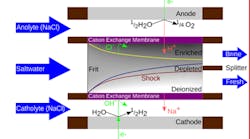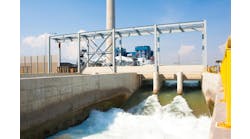A continuous and scalable shock electrodialysis (SED) system can remove up to 99.99% of salt from water and recover almost 80% of the feed stream as deionized water, report researchers at the Massachusetts Institute of Technology, Cambridge, Mass. Possible applications include brackish water desalination, wastewater recycling, ultrapure water production and treatment of water from fracking, they say.
Figure 1. A boost in current causes a shockwave that enables a physical barrier to separate deionized water from brine. Source: M.I.T.
It is “a fundamentally new and different separation system,” notes Martin Bazant, professor of chemical engineering at the school.
In the SED system, salty water flows through porous glass frit with membranes or electrodes on either side. Passing a current through the system causes the water to split into salt-enriched and salt-depleted zones. Then, raising the current to a certain point generates a shockwave between the zones that sharply divides them, enabling a physical barrier in the flow path to separate the streams (see Figure 1). More details on the technology appear in a recent article in Environmental Science and Technology Letters.
[javascriptSnippet ]
The system can remove a wide variety of contaminants other than salt. “For treating low-salinity streams, e.g., removing toxic ions (lead, arsenic, boron, copper…) from drinking water, this method achieves much greater ion removal… than competing methods like capacitive deionization,” Bazant says.
“…Since the fresh water stream extracted behind the shockwave passes through a porous material with a large electric field, it undergoes microfiltration as well as disinfection,” he adds.
Because the water flows across, rather than through the membranes, they are less vulnerable to fouling or degradation from water pressure than those in conventional membrane-based desalination, including electrodialysis, Bazant explains.
The team now is focusing on improving energy and current efficiency by replacing the bare silica glass frit with different materials, and on scale-up. “We expect to reduce energy cost significantly and also demonstrate the possibility of scale-up (e.g., a stack of several layers, larger areas) in the next 6–12 months,” he says.
“We are discussing with several potential partner companies that could help with commercialization and scale-up. This could begin as soon as summer 2016, although we may decide to wait longer in order to focus on understanding and optimizing the properties of the lab-scale system and, thus, ‘de-risk’ the technology further prior to commercialization. We also will be working on identifying the most promising initial applications and developing our business plan.”

